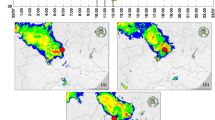Daily variations of integrated water vapor content in the atmosphere in the region of the Nizhnekamsk HPP were examined, from measurement data of GNSS radio signals in autumn 2010. It was established that the difference of these variations between the remote station and the stations at the buildings of the HPP were caused by evaporation from the surface of the water reservoir, and has an expressed daily variation with a maximum at 12:00 UTC and a range approximately the variation of 0.4 kg/m2.
Similar content being viewed by others
References
J. A. Behr, K.W. Hudmit, and N. E. King, “Monitoring structural deformation at Pacoima Dam, California using continuous GPS,” in: Proceedings of ION GPS, ION, Nashville, Tennessee, pp. 59 – 68 (1998).
G. Dardanelli, G. La Loggia, N. Perfetti, F. Capodici, L. Puccio, and A. Maltese, “Monitoring displacements of an earthen dam using GNSS and remote sensing,” in: Remote Sensing for Agriculture, Ecosystems, and Hydrology XVI, SPIE (2014).
Z. Jia, G. Liu,W.Wang, and Y. Zhou, “GNSS investigation in the early stage of the Three Gorges project on the Yangtze River,” in: Geo-Informatics in Resource Management and Sustainable Ecosystem (GRMSE, Wuhan, 2013), pp. 389 – 396 (2013).
D. R. Rutledge, S. Z. Meyerholtz, N. E. Brown, and C. S. Baldwin, GPS World, 17, 26 (2006).
V. V. Kalinnikov and O. G. Khutorova, “Some regularities of gradient parameters of GNSS tropospheric delay in Europe,” Sovr. Probl. Dist. Zond. Zemli Kosmosa, 16(6), 60 – 71 (2019).
A. Dai, J. Wang, R. H. Ware, and T. Van Hove, “Diurnal variation in water vapor over North America and its implications for sampling errors in radiosonde humidity,” J. Geophys. Res. Atmos, 107, ACL 11-1 – ACL 11 – 14 (2002). DOI: 10.1029/2001JD000642.2002
V. V. Kalinnikov and O. G. Khutorova, “Diurnal variations in integrated water vapor derived from a GPS ground network in the Volga – Ural region of Russia,” Ann. Geophys., 35, 453 – 464. DOI: 10.5194/angeo-35-453-2017.
J. P. Ortiz de Galisteo, V. Cachorro, C. Toledano, B. Torres, N. Laulainen, Y. Bennouna, and A. de Frutos., “Diurnal cycle of precipitable water vapor over Spain,” Q. J. Roy. Meteor. Soc., 137, 948 – 958 (2011).
V. V. Kalinnikov, A. V. Ustinov, and R. V. Zagretdinov, “Influence of irregularities of water vapor field in the surface layer of the atmosphere on the results of satellite monitoring of hydropower structures in the region of reservoirs,” Power Technol Eng., 52, 259 – 264 (2018). DOI: https://doi.org/10.1007/S10749-018-09420.
A. Mehran, E. A. Clark, and D. P. Lettenmaier, “Spatial variability of wet troposphere delays over inland water bodies,” J. Geophys. Res., 122, 11,329 – 11,346.
A. E. Niell, “Global mapping fimctions for the atmosphere delay at radio wavelengths,” J. Geophys. Res. Sol. Ea., 101, 3227 – 3246 (1996).
G. Chen and T. A. Herring, “Effects of atmospheric azimuthal asymmetry on the analysis of space geodetic data,” J. Geophys. Res., 102, 20,489 – 20,502 (1997).
M. Bevis, S. Businger, S. Chiswell, T. A. Herring, R. A. Anthes, C. Rocken, and R. H. Ware, J. Appl. Meteorol., 33, 379 (1994).
J. Saastamioinen, “Contributions to then theory atmospheric refraction. Part II. Refraction corrections in satellite Geodesy,” Bull. Geod., No. 107, 13 – 34 (1973).
J. Askne and H. Nordius, “Estimation of tropospheric delay for microwaves from surface weather data,” Radio Sci., 22(3), 379 – 386 (1987).
V. B. Mendes, Modeling the Neutral-Atmospheric Propagation Delay in Radiometric Space Techniques. Tech. Report No. 199, UNB, New Brunswick (1999).
Y. A. Virolainen, Y. M. Timofeyev, V. S. Kostsov, D. V. Ionov, V. V. Kalinnikov,M. V. Makarova, A. V. Poberovsky, N. A. Zaitsev, H. H. Imhasin, A. V. Polyakov, M. Schneider, F. Hase, S. Barthlott, and T. Blumenstock, “Quality assessment of integrated water vapor measurements at the St. Petersburg site, Russia: FTIR vs. MW and GPS techniques,” Atmos. Meas. Tech., 10, 4521 – 4536 (2017). DOI: https://doi.org/10.5194/amt-10-4521-2017.
L. T. Matveev, Fundamentals of General Meteorology: Physics of the Atmosphere, Program for Scientific Translations, Jerusalem (1967).
Author information
Authors and Affiliations
Corresponding author
Additional information
Translated from Gidrotekhnicheskoe Stroitel’stvo, No. 1, pp. 43 – 46, January, 2021. DOI: 10.34831/EP.2021.95.72.005
Rights and permissions
About this article
Cite this article
Kalinnikov, V.V., Ustinov, A.V., Khutorova, O.G. et al. An Illustration of the Possibility of Using GNSS Observations to Measure Evaporation Over a Reservoir Using the Example of Nizhnekamsk HPP. Power Technol Eng 55, 168–171 (2021). https://doi.org/10.1007/s10749-021-01336-w
Published:
Issue Date:
DOI: https://doi.org/10.1007/s10749-021-01336-w




